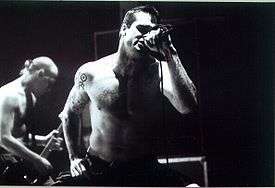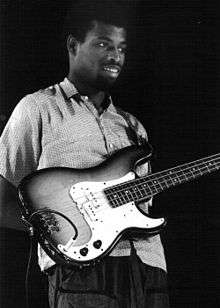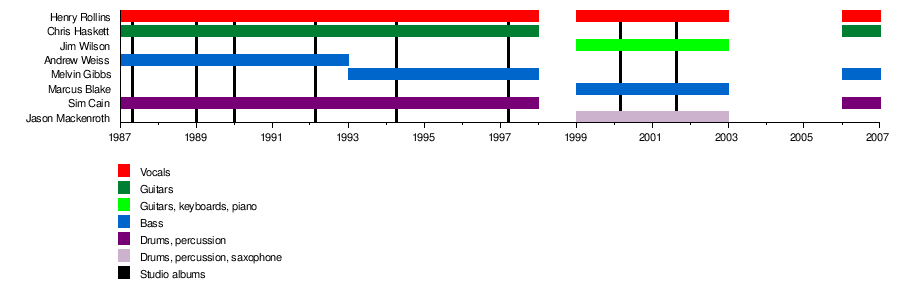Rollins Band
| Rollins Band | |
|---|---|
 Henry Rollins, founder and frontman with Chris Haskett (background) | |
| Background information | |
| Also known as | The Rollins Band |
| Origin | Van Nuys, California, U.S. |
| Genres | |
| Years active | 1987–1997, 1999–2003, 2006 |
| Labels | |
| Associated acts | |
| Website |
21361 |
| Past members |
|
Rollins Band was an American rock band led by singer and songwriter Henry Rollins.
They are best known for the songs "Low Self Opinion" and "Liar", which both earned heavy airplay on MTV in the mid-late 1990s. Critic Steve Huey describes their music as "uncompromising, intense, cathartic fusions of funk, post-punk noise, and jazz experimentalism, with Rollins shouting angry, biting self-examinations and accusations over the grind."[1]
In 2000, Rollins Band was included on VH1's 100 Greatest Artists of Hard Rock, ranking at No. 47.[2]
History
Precursors (1980–1986)
Rollins was the singer for the Washington, D.C. punk rock band State of Alert from October 1980 to July 1981. Afterwards, he sang with California punk rock band Black Flag from August 1981 to August 1986. Black Flag earned little mainstream attention, but through a demanding touring schedule, came to be regarded as one of the most important punk rock bands of the 1980s.
Less than a year after Black Flag broke up, Rollins returned to music with guitarist Chris Haskett (a friend from Rollins' teen years in Washington D.C.), bass guitarist Bernie Wandel, and drummer Mick Green.
This line-up released two records: Hot Animal Machine (credited as a Rollins solo record and featuring cover art drawings by Devo leader Mark Mothersbaugh) and Drive by Shooting (credited to "Henrieta Collins and the Wifebeating Childhaters"). The music was similar to Black Flag's, though it flirted more with heavy metal and funk.
First edition (1987–1994)
Soon after, Rollins formed Rollins Band with Haskett, bassist Andrew Weiss, and drummer Sim Cain (Weiss and Cain had previously played with Gone, an instrumental rock group led by guitarist and Black Flag founder Greg Ginn). Live sound engineer Theo Van Rock was usually credited as a band member.
Critics Ira Robbins and Regina Joskow described this line-up as a "brilliant, strong ensemble ... the band doesn't play punk (more a jazzy, thrashy, swing take on the many moods of Jimi Hendrix), but what they do together has the strengths of both. The group's loud guitar rock with a strong, inventive rhythmic clock borrows only the better attributes of metal, ensuring that noise is never a substitute for purpose."[3]
Second edition (1994–1997)

Rollins's tour diaries from this era (published as See A Grown Man Cry and "Now Watch Him Die") details the personal and creative tensions that led to Weiss being fired following the End of Silence tour.
 |
"Another Life" (1992)
30 second sample of the The End of Silence track "Another Life". |
| Problems playing this file? See media help. | |
 |
"Wrong Man" (1994)
30 second sample of the Weight track "Wrong Man". |
| Problems playing this file? See media help. | |
The band's new bassist was jazz and funk veteran Melvin Gibbs, who'd been highly recommended by guitarist Vernon Reid of Living Colour, a friend of the Rollins Band since the first Lollapalooza tour. Cain and Gibbs had also both played in different versions of guitarist Marc Ribot's band (with Gibbs performing on Ribot's album Rootless Cosmopolitans and Cain on Requiem for What's-His-Name).
The first video from 1994's Weight, "Liar", was a huge hit on MTV, with Rollins sporting numerous costumes (including a cop and a nun). The band appeared at Woodstock '94, and Rollins was a guest-host for several MTV programs, including 120 Minutes.
This version of Rollins Band had some of the most overt jazz leanings of the band's history: Gibbs had begun his career with Reid in the 1980s jazz fusion group of drummer Ronald Shannon Jackson, and worked with Sonny Sharrock on albums like 1987's Seize The Rainbow. These influences, along with Rollins' obsession with the late '60s/early '70s electric/fusion era of iconic trumpeter Miles Davis, shaped this version of the band's music. During the sessions for Weight, Rollins Band recorded with free jazz saxophonist Charles Gayle, though these sessions remained unreleased for ten years at Gayle's request to avoid conflicts with his contractual obligations. The Gayle sessions were released in 2003 as Weighting.
In 1996, there was a legal battle with the band's former label Imago Records. Rollins claimed "fraud, deceit, undue influence and economic coercion" on the labels' part.[4] They signed with the then new major label DreamWorks Records, who released 1997's Come In And Burn. The album had a minor hit with the single "Starve" and the band appeared on Saturday Night Live to promote the album (season 22, episode 18). However, Come In and Burn was not as successful as Weight and, after touring for Burn, Rollins dissolved the group, citing creative stagnation.
Third edition (1999–2003)
Rollins replaced the Haskett-Gibbs-Cain lineup with the Los Angeles rock band Mother Superior, retaining the name Rollins Band, and released Get Some Go Again (2000) and Nice (2001). They also released a two-disc live album, The Only Way to Know for Sure. This line-up was a more straightforward hard rock group: their first album featured "Are You Ready?" a cover of a Thin Lizzy song, featuring Lizzy guitarist Scott Gorham; Rollins has often expressed fondness for Thin Lizzy and its founder, Phil Lynott.
 |
"On My Way to the Cage" (1997)
30 second sample of the Come In and Burn track "On My Way to the Cage". |
| Problems playing this file? See media help. | |
 |
"One Shot" (2001)
30 second sample of the Nice track "One Shot". |
| Problems playing this file? See media help. | |
Fourth edition (2006)
In between other commitments (His radio show Harmony In My Head, his cable/satellite TV show The Henry Rollins Show, and his spoken word tours), Rollins also reunited the Haskett-Gibbs-Cain lineup.[5] In a blog entry on henryrollins.com, Rollins admitted, "Actually we have been practicing on and off for months now, slowly getting it together ... It's been really cool being back in the practice room with these guys after all these years."[6]
The band opened some concerts for X, and played on the first-season finale of The Henry Rollins Show on August 12, 2006.[7]
Indefinite hiatus (2007–present)
Rollins told Alan Sculley of The Daily Herald that this reunion with Haskett, Gibbs and Cain would not become long-term unless the group decided to write new songs: "Let's put it this way. I don't want to go out and hit America again without a new record, or at least a new album's worth of material. Otherwise the thing will lack legitimacy ... Miles Davis would never do that. And I'm not into a greatest-hits thing. I think a band, if you're going to be around, you should be moving forward and putting in the time and working for it, getting after the art. Otherwise you're just playing retreads. ... Imagine a tree that grows canned peaches. It's nothing I want to do."[8]
In 2014, Rollins admitted a disdain for rehashing old music for the sake of it – "I don’t want to play old music. To me, it is fighting battles that are already over and calling yourself a warrior. For me, I see no courage or adventure in doing the old thing over again. If others want to, that’s for them. For myself, I have to move on. Life is too short to live in the past. There is a lot to be done."[9]
Former member Jason Mackenroth died on January 3, 2016, in Nevada from prostate cancer.[10]
Musical style and influences
The band have been categorized under the alternative metal, hard rock, funk metal and post-hardcore genres.[11][12][13][14] Mid-career albums such as Weight also had a pronounced jazz influence.[15][16] They were part of the early '90s LA alternative metal scene, alongside Tool, Jane's Addiction, Rage Against the Machine and Green Jellÿ.[13] Their influences include '70s metal and rock bands, including Black Sabbath, The Velvet Underground, Pink Fairies and Thin Lizzy.[11] Rollins' shout-singing style proved influential to later alternative and nu metal artists, such as Coal Chamber, Korn, Chevelle, Godsmack and System of a Down.[11] The Rollins Band songs "Tearing" and "Shine" have been covered by Pearl Jam.[17]
Band members
- Last line-up
- Henry Rollins – lead vocals (1987–2003, 2006)
- Chris Haskett – guitar (1987–1997, 2006)
- Sim Cain – drums, percussion (1987–1997, 2006)
- Melvin Gibbs – bass (1993–1997, 2006)
- Former members
- Andrew Weiss – bass (1987–1992)
- Jim Wilson – guitar, piano (1999–2003)
- Marcus Blake – bass (1999–2003)
- Jason Mackenroth – drums, percussion, saxophone (1999–2003)
- Theo Van Rock – sound engineer
Timeline

Discography
Studio albums
- Life Time (1987, re-release 1999)
- Hard Volume (1989, re-release 1999)
- The End of Silence (1992, double-CD re-release 2002) No. 160 US
- Weight (1994) No. 33 US, No. 22 UK, No. 10 AUS[18]
- Come In and Burn (1997) No. 89 US, No. 38 AUS[19]
- Get Some Go Again (2000) No. 180 US, No. 40 AUS[20]
- Nice (2001) No. 178 US
Outtakes and demos collections
- A Nicer Shade of Red (2001)
- The End of Silence Demos (2002)
- Yellow Blues (2003)
- Weighting (2004)
- Come In and Burn Sessions (2004)
- Get Some Go Again Sessions (2005)
Live albums
- Live Split Album with Dutch band Gore – Recorded @ El Mocambo, Toronto, Ontario 5.17.87 (1987)
- Do It – Studio Outtakes and Live (1988)
- Turned On (1990)
- Electro Convulsive Therapy (1993)
- Insert Band Here: Live In Australia, 1990 (1999)
- A Clockwork Orange Stage (2001)
- The Only Way to Know for Sure: Live in Chicago (2002)
EPs and 7" singles
- Live in Deventer, Holland, October, 1987 (1988) (7" single)
- I Know You b/w Earache My Eye (1990) (Sub Pop 7" single)
- Tearing (1992) No. 54 UK
- Low Self Opinion (1992)
- Hammer of the Rök Gödz (1992) (EP)
- You Didn't Need (1992) (radio promo)
- Liar (1994)
- Liar / Disconnect (1994) No. 27 UK
- "Disconnect" (1994)
- Fool (1994) (2x12" promo)
- The End of Something (1997)
- "Starve" (1997)
- Illumination (2000)
- Get Some Go Again (2000)
- Your Number Is One (2001) (radio promo)[21]
Miscellaneous
Other appearances
| Year | Song | Album |
|---|---|---|
| 1994 | "Ghost Rider" | Crow soundtrack |
| 1995 | "Four Sticks" | Encomium: A Tribute to Led Zeppelin |
| 1995 | "Fall Guy" | Demon Knight (soundtrack) |
| 1995 | "I See Through" | Johnny Mnemonic soundtrack |
| 2001 | "What's the Matter Man" | Tony Hawk's Pro Skater 3 soundtrack |
References
- ↑ "Henry Rollins" from Allmusic.com; URL accessed April 16, 2008
- ↑ "VH1: 100 Greatest Hard Rock Artists: 1–50". Rock On The Net. Retrieved 2016-01-06.
- ↑ "Rollins Band". TrouserPress.com. Retrieved 2016-01-06.
- ↑ "Henry Rollins Sues Imago Records". MTV News. Retrieved 24 February 2016.
- ↑ "Rollins Band returns". Punknews.org. 2006-03-31. Retrieved 2016-01-06.
- ↑ 21361.com Archived February 17, 2009, at the Wayback Machine.
- ↑ Roadrunnerrecords.com Archived June 7, 2011, at the Wayback Machine.
- ↑ Hearld Extra Archived February 15, 2009, at the Wayback Machine.
- ↑ Kevin Wells. "EXCLUSIVE INTERVIEW: Henry Rollins speaks about punk rock". Commdiginews.com. Retrieved January 18, 2015.
- ↑ Doc Rock. "The Dead Rock Stars Club 2016 January to June". Thedeadrockstarsclub.com. Retrieved 2016-01-06.
- 1 2 3 "Rollins Band | Biography, Albums, & Streaming Radio". AllMusic. Retrieved 2016-01-06.
- ↑ Bradley, Stephen (September 22, 2010). "Concert review: Kevin Seconds". The Washington Times Communities – Riffs. Retrieved October 27, 2011.
[...] Where most punks from the '80s hardcore scene made the transition into hard rock or post hardcore outfits like Rollins Band and Fugazi, it still seems natural that he would make the jump into the acoustic side of things. [...]
- 1 2 Grow, Kory (2013-03-20). "Not a Downer: Tool's Adam Jones Talks 'Opiate' Reissue, New Material | SPIN | Q & A". SPIN. Retrieved 2013-03-28.
- ↑ Chris True. "Life Time". AllMusic. Retrieved 24 February 2016.
- ↑ "Rollins Band, 'Weight'". Rolling Stone. Retrieved 24 February 2016.
- ↑ "Lollapalooza 1991: Where are the stars now?". USATODAY.COM. Retrieved 24 February 2016.
- ↑ "Pearl Jam Music". Pearljam.com. Retrieved 2016-01-06.
- ↑ Steffen Hung. "Rollins Band – Weight". australian-charts.com. Retrieved 2011-07-09.
- ↑ Steffen Hung. "Rollins Band – Come In And Burn". australian-charts.com. Retrieved 2011-07-09.
- ↑ Steffen Hung. "Rollins Band – Get Some Go Again". australian-charts.com. Retrieved 2011-07-09.
- ↑ Roberts, David (2006). British Hit Singles & Albums (19th ed.). London: Guinness World Records Limited. p. 469. ISBN 1-904994-10-5.